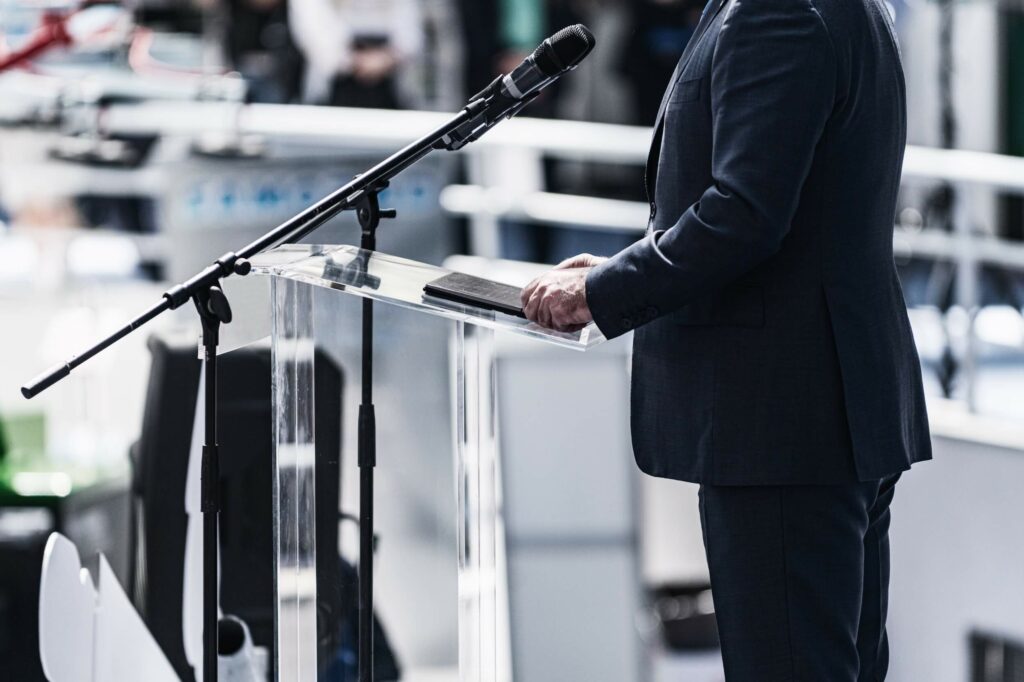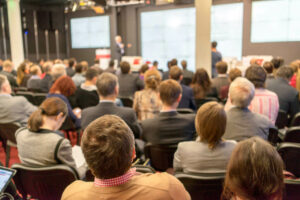When Chancellor Olaf Scholz broke up the traffic light system on November 6th with the dismissal of Finance Minister Lindner, it was clear that new elections were just around the corner. Discussions about the date of the 2025 Bundestag elections dominated the media in the coming days. Whether it was the CDU/CSU with Merz and Söder, the SPD, the Greens or the FDP, everyone had their own ideas about when the right time would be. Even the Federal Election Commissioner got involved. In the style of Michael Ballack’s legendary ‘calf of the nation’, one could even have spoken of the ‘paper of the nation’, so much did the possible shortage move the debates on television and at the regulars’ table. Even neighbouring countries offered their help to supply the paper needed for the ballot papers if necessary.
More livestreaming as a result of the short election campaign period
But as strange, funny and awkward as many a political appearance has seemed these days, the election campaign machinery has already started up in the party offices. The upcoming election will take place in less than two months and in the middle of winter. A particular challenge for the parties and leading candidates. And the answer to this could be above all Livestream!
At least that’s what Martin Prankl thinks. Our Managing Director of Stream1 has already provided communications support for several election campaigns and streamed numerous election events. He is certain that this general election will also be a livestream election.
‘Circumstances are forcing the parties into the digital world. The lead time to the election is very short, the months-long planned election campaign on the streets, at doorsteps or synchronised campaign events can only be implemented to a limited extent in the short time available,’ says Martin Prankl.
The weather does the rest, because who will voluntarily stand at the information stand in January or February or freeze during a speech on the market square?
Habeck has presented on YouTube: Video from the kitchen
Robert Habeck has already positioned himself as the Green Party candidate. In his public candidature speech, broadcast on YouTube, he sat at a kitchen table.
‘He wants to emphasise his down-to-earth attitude and closeness to the people. In 2025 in particular, politicians will want to present themselves as ‘politicians you can touch’ and demonstrate their approachability,’ predicts Martin.
What better way to do this than via livestream or video? Especially in view of the fact that in January or February, even die-hard party supporters will probably prefer the warmth of the living room to a speech in the cold. Because while the technology for livestreams in election campaigns has been around for years, we are now also seeing a change in citizens’ behaviour.
‘Due to coronavirus in particular, participating in video calls and digital events has become the norm in both professional and private contexts. People are more tech-savvy and have become accustomed to this form of information transfer. But until now, it was mainly politicians who struggled to make the leap into the digital world. Driven primarily by a young generation of politicians, we are noticing that more and more mature politicians are also appearing on Instagram and TikTok.’
Live means authentically convincing
Not all of them are equally convincing, but almost all of them have recognised the need for a professional digital presence. Habeck’s video was a recording, but if you really want to appear authentic in the election campaign, there is no way around a live stream. Live moving images, live streams or live broadcasts enable a whole new kind of interaction with the audience.
‘For politicians, this creates an area of tension. For years, many have paid meticulous attention to their appearance and public image. Every scene in a video is repeated dozens of times until the smile is perfect. Speaking with a teleprompter is practised until it looks natural. And which politician doesn’t practise their important speeches in front of a mirror or camera before appearing in parliament or a beer tent?’
But livestreams thrive on their spontaneity and unpredictability. How a politician reacts to unplanned events in the stream or provocative comments in the chat will also be important in 2025.
‘Authenticity is perhaps the buzzword in today’s election campaigns. It scares some candidates. Fortunately, however, there are communication techniques for appearing confident on stream. Of course, a livestream also means stress at first, but it offers unique opportunities to make a likeable impression,’ says Martin reassuringly.
And a livestream has another major advantage: individual scenes can be cut out of the livestream afterwards and played out as short-form video content on Instagram, TikTok or other social media platforms. ‘These spontaneous reactions from politicians achieve a much greater reach and impact than videos that have been planned down to the last detail.’
We expect these types of livestreaming in the 2025 federal election campaign
- Accompanying live streams directly from everyday life
- Moderated interviews and talk formats with professional moderators
- Livestreaming from a livestream studio
- Influencer Liveshows
- Podcasts und Videopodcasts
- Livestreams directly on the parties’ websites
- Social Media Livestreams bei Instagram, Facebook und TikTok
Accompanying live streams directly from everyday life
Who wouldn’t want to be there live for 24 hours when a top politician meets other heads of state, answers questions from persistent journalists or discusses issues with his colleagues? Allowing viewers at home to immerse themselves in the complex world of politics for a day would not only help the reputation of individual politicians, but the entire sector. A 24-hour stream can awaken citizens’ understanding of the complicated decisions that are made every day in Berlin, Munich or Brussels.
‘Thanks to modern streaming technology, a high-quality stream can be realised from anywhere. We recently streamed non-stop for 9 hours while travelling from Munich to Amsterdam – at 150 km/h’ Martin Prankl refers to the latest high-performance streaming experiment.
Moderierte Interviews und Gesprächsformate mit professionellen Moderatoren
This form of live transmission is particularly suitable for less digitally savvy politicians. The entry-level live stream, so to speak. Similar to a TV programme, a presenter conducts an interview. However, unlike a recorded TV show, viewers can submit questions. The presenter or a team in the background then selects the questions that will ultimately be asked. If this pre-selection is made by the campaign team, the questions that best suit the candidate can be selected. The politician only has to be able to rely on the judgement of his team.
‘We have already streamed numerous political interviews, regularly from our streaming studio at the Munich Security Conference. The political elite virtually held hands there. As a result, we know what it takes to stage and broadcast convincing political interviews’, says Martin Prankl, referring to streamed interviews with Baerbock, Scholz and co. in recent years.
Influencer Liveshows
Influencers have also long played a role in politics. While in business it is monetary arguments that convince influencers to review or recommend products, in politics it is usually their own values. Celebrities support the candidates they themselves believe in. In the US election campaign, for example, megastar Taylor Swift campaigned for the election of Kamala Harris, while tech mogul Elon Musk appeared with Donald Trump.
‘In Germany, celebrities are generally more reserved, but stars from music, sport and TV have also positioned themselves politically in the past. Due to the hype that influencer marketing has experienced in recent years and the presumably close election results, more celebrities in Germany could also be inclined to use their reach and popularity ratings to appear in livestreams together with politicians this time.’
Livestreaming from a livestream studio
The effect created by a video or livestream is determined not only by the appearance of the streamer but also by the setting, the background and the atmosphere. Image quality, the design of overlays, convincing sound and professional lighting also play an important role in perception.
‘We can create different settings in our livestream studio in Munich: Whether it’s a relaxed lounge atmosphere for interviews and informal talks or serious seating for virtual panel discussions and press conferences. Of course, we can also set up our mobile studio directly on your premises at any time and stream from the location of your choice’ Martin promises with a view to the livestream studio in Munich.
Political podcasts and video podcasts
Podcasts are audio formats that are becoming increasingly popular. The advantage: interviews and discussions can be easily followed during everyday activities. Some listen to podcasts while jogging, others while doing the housework. Numerous active or former politicians such as Gregor Gysi or Theodor zu Guttenberg as well as journalists such as Markus Lanz regularly publish podcasts with political content. Recently, so-called video podcasts have also been booming. These are basically normal podcasts, the recording of which is filmed and then published as a video. Either in full length on YouTube or as individual snippets as Instagram Reel, YouTube Shorts or on TikTok.
‘The production of an appealing podcast demands special requirements in terms of sound quality and, in the case of video podcasts, also in terms of image quality, editing and lighting. That’s why we are now also realising this in our livestream studio, Martin is delighted about the growing demand for our video podcast productions.
Livestreams directly on the party’s website
Livestreams can not only be broadcast on social media, but also directly on a website. Especially during the election campaign, citizens will visit the parties’ websites to find out about the respective election programme.
‘With a livestream or an entertaining video, you can engage website visitors much more intensively and also reach them more easily on an emotional level than with pure text or classic election programmes,’ explains Martin.
Social media livestreams on Instagram, Facebook and TikTok
The typical platforms for live streaming are, of course, the social networks of Meta and TikTok. Live streaming is literally possible with just one click. But be careful: an unplanned live stream can easily backfire for the digitally inexperienced. So before you go live on social media for the first time, you should seek comprehensive advice to ensure that the stream has the desired effect. The advantage of social media: Users don’t expect the most sophisticated technology. A natural, spontaneous appearance in particular comes across as likeable and popular.
‘The possibilities for streaming ideas on social media are almost limitless. Politicians can answer questions live or show their office or home. Similarly, joint streams with other politicians can also be easily realised. Or why not react live to other politicians’ speeches in so-called reaction videos? Or deliberately present your own content for discussion?’
Of course, pure livestream platforms such as Twitch are also potentially interesting, but at least in Germany, political livestreams have not been able to establish themselves there in the long term. YouTube, on the other hand, is more promising because users there have always been used to political content.
Important questions before a political livestream
- What is the purpose of a livestream?
- Who is the target group?
- Which format is the right one?
- Should the stream be accessible?
What is the purpose of a livestream?
Organising a stream just to appear hip and modern is usually not a good idea. Instead, you should be clear about what you want to achieve with each livestream. Do you want to comment on current debates, do you want to provide information about the content of the programme or do you want to hear the opinions of citizens, for example in the form of a kind of citizens’ consultation? Depending on the purpose, different livestream solutions and formats are available.
Who is the target group?
Similar to the purpose, you should always consider in advance which people you want to reach. Every target group communicates in a different way and therefore has different expectations of a stream. The choice of platform also depends on the definition of the core target group. Younger internet users expect a different approach than older users. They are much more experienced in the use of social media and are generally also interested in other aspects of the election programme than senior citizens, for example.
Which format is the right one for a political stream?
The classic live stream transmits images and sound to the viewers. So far, so good. It gets exciting when a reaction is hoped for. Linear broadcasting without feedback no longer really deserves to be called a livestream. Popular streaming platforms such as YouTube, TikTok, Twitch and Instagram thrive on the reaction of users. Viewers not only want to communicate with the streamer, they also want to interact with each other. It is precisely this more or less uncontrollable dynamic that can arise in the comments of a stream that can sometimes take on unsavoury characteristics in the political sphere.
‘In our live broadcasts, we always work according to the wishes of our customers. We stream directly to social media as well as to our own platforms with servers in Germany. We offer streams both without access restrictions and with registration. Our customers are just as free in their choice of chat. A chat that is visible to everyone is possible, as is a pure 1-to-1 chat with the streamer or team in the background. It is also possible to set whether the individual viewers should see the other participants in the stream or not,’ says Martin, describing the many possibilities .
Should the policy stream be barrier-free?
As a party and candidate, you want to reach everyone. With this in mind, an accessible stream is increasingly in demand. And nowadays, fortunately, this accessibility is no longer too much of a problem. Modern speech-to-text technologies convert spoken words into text simultaneously and, thanks to AI, with extreme precision. However, sign language interpretation is also common in many streams.
‘We have been working with various interpreters for years, both for sign language and for other languages. More and more voters are now non-native German speakers, which means that multilingual streams are increasingly being implemented.’ explains Martin Prankl with regard to streams with interpreters.




